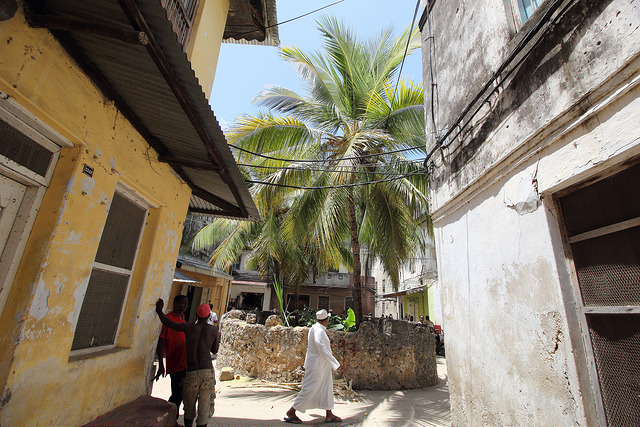Eating in the Spice Islands

I try to control the expression on my face so I don’t offend the man holding out the squishy, grey blob of limbs. “No, I don’t need an octopus today, thank you.” Another man pushes past me—shoving me dangerously close to the proffered cephalopod—with a tray of chicken gizzards, calling out his prices to the bustling crowd in Darajani Market, Stone Town, Zanzibar. The heart of what were once known a the Spice Islands.
When most tourists visit the market, they find themselves overcome by a sea of rushing people, discordant shouting, and unidentified smells. Tour guides tell them to hold tight to their wallets and step carefully around the tarps laden with fruit and vegetables.
They do as they’re told, snap a few pictures if they’re brave, then head back to the hotel district for lunch in a café with a Western menu. For residents of Zanzibar however, Darajani provides what may be the single most important element of any culture: food.
Food is at the forefront of any gathering, even an unannounced visit to a friend’s home, and it is served in exceedingly generous portions.
Famous for its history in trading spices such as cinnamon, cardamom, cloves, vanilla and nutmeg, Zanzibar has developed a unique cuisine that combines notes from its Arab, Indian, European and African influences. While African cuisine is not nearly as widely sampled as Chinese, Greek or French is in the US, it is no less distinctive. And the locals know it. Food is at the forefront of any gathering, even an unannounced visit to a friend’s home, and it is served in exceedingly generous portions.
As a tourist in Zanzibar last year, I thought I understood this aspect of the culture. I enjoyed plates of pilau—a rice dish that features all the island’s famous spices—and biriyani—a rice dish originating from Indian cuisine. But I did so only in the cafes I visited with other tourists, the ones with foreign chefs and Western prices. The most complicated cooking I attempted involved a bowl, cereal, and milk.
Now, having lived here for nine months, I am not a tourist. And while the pilau and biriyani are still delicious, I am learning that the local food is much more complicated than most guidebooks suggest.
Famous for its history in trading spices, Zanzibar has developed a unique cuisine that combines notes from its Arab, Indian, European and African influences.
After a week and a half eating street foods like chips mayai (French fries cooked in an omelet), juice ya tende (dates, nuts and frozen milk) and Zanzibar pizza (a vaguely crepe-like, fried concoction filled with vegetables and meat) I knew I needed to either change my diet or find a seamstress to alter my wardrobe. So my Zanzibari boyfriend and I ventured to the market.
As we approached the chaos, I was happy to have a local to guide me through it. I picked out an avocado the size of a grapefruit, some bananas the size of my thumb, and a pile of pale green oranges. My boyfriend negotiated in Swahili and I made a note of the new vocabulary for future solo trips.
Carbs take center stage here, usually in the form of rice or the quintessential Eastern African food, ugali.
The most immediate difference between food in Zanzibar and food in the US: in Zanzibar it’s fresh. Really fresh. If you visit the market at 6am, you’ll see trucks from the island’s smaller villages unloading gigantic piles of coconuts, mangoes, potatoes and onions.
And if you venture to the harbor, you’ll find boats filled with freshly netted fish, or samaki, the most inexpensive protein option. Samaki is so popular there’s a bus route named after it.
Fish–or any protein for that matter–usually takes the place of a side dish rather than the main event. Zanzibari cuisine does not feature meat the same way American dishes do. Carbs take center stage here, usually in the form of rice or the quintessential Eastern African food, ugali.
The most immediate difference between food in Zanzibar and food in the US: in Zanzibar it’s fresh. Really fresh.
The first time I made ugali, I almost broke the spoon. This stiff cornmeal porridge has a flavor similar to rice with the consistency of dough. It is not served in the tourist restaurants in Stone Town (probably to preserve the cookware), but it is a staple in most home kitchens and establishments that cater to locals.
It is usually served with fried fish and sautéed spinach. Ugali is designed to be eaten by hand, as spoons are optional with most local meals.
Though common, ugali fulfills a strangely important role as a test for foreigners in Zanzibar. Besides “do you speak Swahili?”, the most frequent question I get is “have you had ugali yet?” When I answer in the affirmative, most people laugh out loud. Exclusive and typical to local life, ugali is a symbol of the local Zanzibari culture, the one most tourists don’t see.
I’ve learned that Zanzibari cuisine has much more to offer than the few featured dishes most foreigners taste.
While from time to time I still crave the pizza and hamburgers sold in the tourist restaurants, I’ve learned that Zanzibari cuisine has much more to offer than the few featured dishes most foreigners taste. Food in Zanzibar serves as a pervasive symbol of the culture’s hospitality and diversity. And, of course, no dish here lacks spice.
Eating in the Spice Islands of Zanzibar
Related Reading
Romance, Health, and Safety in Zanzibar: A Conversation with Katrina Marks
Zanzibar Tourism: Describing My Home to the People of Zanzibar
Girls Getaway to Zanzibar
Volun-touring Versus Volunteering in Zanzibar
The Truth About Zanzibari Men
I Buried My Heart in Zanzibar
Have you traveled to Zanzibar? What were your impressions? Email us at editor@pinkpangea.com for information about sharing your experience and advice with the Pink Pangea community. We can’t wait to hear from you.








